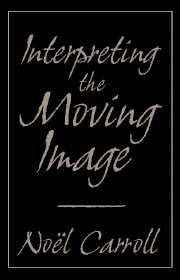Book contents
- Frontmatter
- Contents
- Foreword: Through Carroll's Looking Glass of Criticism
- Introduction
- 1 The Cabinet of Dr. Kracauer
- 2 Entr'acte, Paris and Dada
- 3 The Gold Rush
- 4 Keaton: Film Acting as Action
- 5 Buster Keaton, The General, and Visible Intelligibility
- 6 For God and Country
- 7 Lang, Pabst, and Sound
- 8 Notes on Dreyer's Vampyr
- 9 King Kong: Ape and Essence
- 10 Becky Sharp Takes Over
- 11 Interpreting Citizen Kane
- 12 The Moral Ecology of Melodrama: The Family Plot and Magnificent Obsession
- 13 Mind, Medium, and Metaphor in Harry Smith's Heaven and Earth Magic
- 14 Welles and Kafka
- 15 Nothing But a Man and The Cool World
- 16 Identity and Difference: From Ritual Symbolism to Condensation in Anger's Inauguration of the Pleasure Dome
- 17 Text of Light
- 18 Joan Jonas: Making the Image Visible
- 19 Introduction to Journeys from Berlin/1971
- 20 The Future of Allusion: Hollywood in the Seventies (and Beyond)
- 21 Back to Basics
- 22 Amy Taubin's Bag
- 23 Herzog, Presence, and Paradox
- 24 Film in the Age of Postmodernism
- Notes
- Index
10 - Becky Sharp Takes Over
Published online by Cambridge University Press: 05 June 2012
- Frontmatter
- Contents
- Foreword: Through Carroll's Looking Glass of Criticism
- Introduction
- 1 The Cabinet of Dr. Kracauer
- 2 Entr'acte, Paris and Dada
- 3 The Gold Rush
- 4 Keaton: Film Acting as Action
- 5 Buster Keaton, The General, and Visible Intelligibility
- 6 For God and Country
- 7 Lang, Pabst, and Sound
- 8 Notes on Dreyer's Vampyr
- 9 King Kong: Ape and Essence
- 10 Becky Sharp Takes Over
- 11 Interpreting Citizen Kane
- 12 The Moral Ecology of Melodrama: The Family Plot and Magnificent Obsession
- 13 Mind, Medium, and Metaphor in Harry Smith's Heaven and Earth Magic
- 14 Welles and Kafka
- 15 Nothing But a Man and The Cool World
- 16 Identity and Difference: From Ritual Symbolism to Condensation in Anger's Inauguration of the Pleasure Dome
- 17 Text of Light
- 18 Joan Jonas: Making the Image Visible
- 19 Introduction to Journeys from Berlin/1971
- 20 The Future of Allusion: Hollywood in the Seventies (and Beyond)
- 21 Back to Basics
- 22 Amy Taubin's Bag
- 23 Herzog, Presence, and Paradox
- 24 Film in the Age of Postmodernism
- Notes
- Index
Summary
Becky Sharp is a film that warrants a place in world almanacs; it was the first feature-length movie to be shot completely in three-color Technicolor. Unlike other historic firsts of the medium, such as The Jazz Singer, Becky Sharp (1935) is not marred by the awkwardness of an experiment. Its use of color is various and assured. Its director, Rouben Mamoulian, had already completed seven films. He was brought onto the project in January 1935, after the film's original director, Lowell Sherman, died while just beginning work on the production.
Ostensibly the film is based on Langdon Mitchell's 1899 stage adaptation of W. M. Thackeray's Vanity Fair. But examination of Mitchell's play quickly reveals that scriptwriter Francis Edward Faragoh, though using some of Mitchell's lines and ideas, returned to Thackeray's Vanity Fair, reinstating many of the scenes that the play had deleted: this is understandable since the pace of a 1930s film allowed for far more scene changes than a play did. The film owes more to Thackeray than to Mitchell and is rather an adaptation of the novel than of the play.
Adaptation
Thackeray's Vanity Fair (1847) is a novel on a scale and of a style that present imposing problems for film adaptation. Not only does it run over six hundred tightly printed pages of packed incident, but its emphasis is on comedy of manners rather than on visual description.
- Type
- Chapter
- Information
- Interpreting the Moving Image , pp. 143 - 152Publisher: Cambridge University PressPrint publication year: 1998

